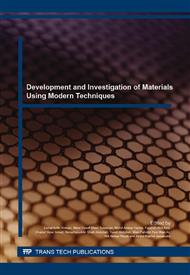p.112
p.118
p.124
p.131
p.141
p.146
p.151
p.156
p.160
Effect of Current Density on Anodised Titanium in Sulphuric Acid for Biomedical Application
Abstract:
Bioinert titanium (Ti) can be modified to bioactive by performing various techniques including anodic oxidation. Where, this method encompasses electrode reactions in combination with electric field driven metal and oxygen ion diffusion to the formation of an oxide film on anode surface. The objective of this study is to evaluate the effect of current density of anodic oxidation upon the characteristic of titanium in sulphuric acid (H2SO4) under various conditions. The modified titanium was prepared using anodic oxidation method in 0.3 M of sulphuric acid as electrolyte. The applied voltage and current density of the anodic oxidation parameters were varied from 50 – 200 V and 25 – 75 mA.cm-2 respectively for 10 min of oxidation process at room temperature. The effects of anodic oxidation on the titanium were characterised using X-ray diffractometer (XRD), field emission scanning electron microscopy (FESEM) and atomic force microscopy (AFM). The results show that by increasing the current density of the anodic oxidation, different mineralogy, surface morphology, and surface profile were produced. At low current density (25 mA.cm-2), high voltage is needed to produce high crystalline of anatase formed on the titanium surface and only able to produced very low of rutile titanium with 200 V of applied voltage compared to high current density (75 mA.cm-2) with same applied voltage, very high rutile crystal with mixture of low anatase was observed on the titanium. This modified oxide of titanium has potentially to be applied in biomedical as implant.
Info:
Periodical:
Pages:
141-145
Citation:
Online since:
January 2016
Keywords:
Price:
Сopyright:
© 2016 Trans Tech Publications Ltd. All Rights Reserved
Share:
Citation:


